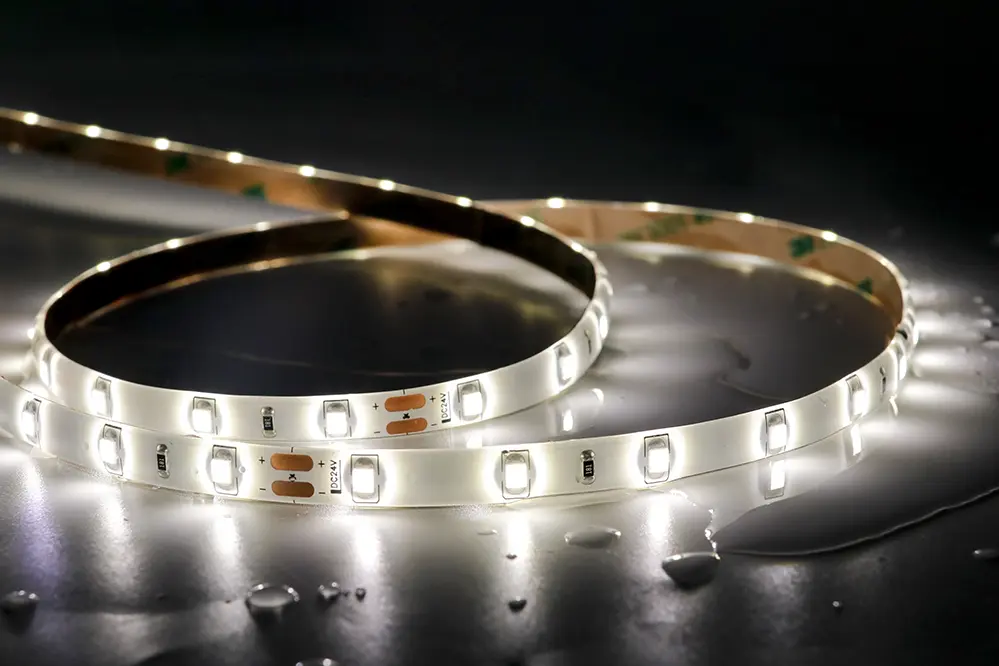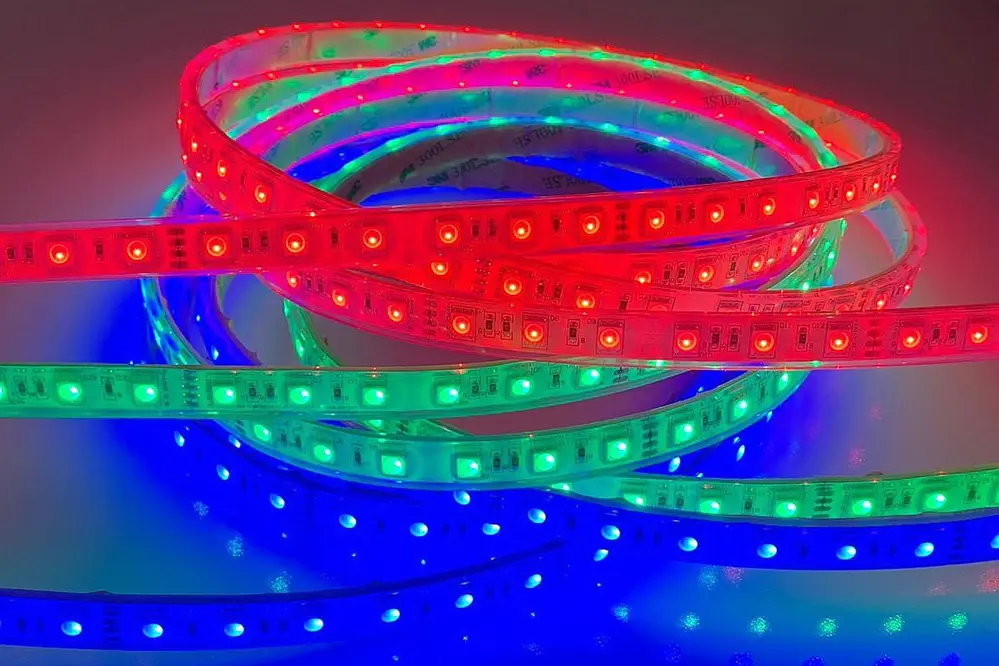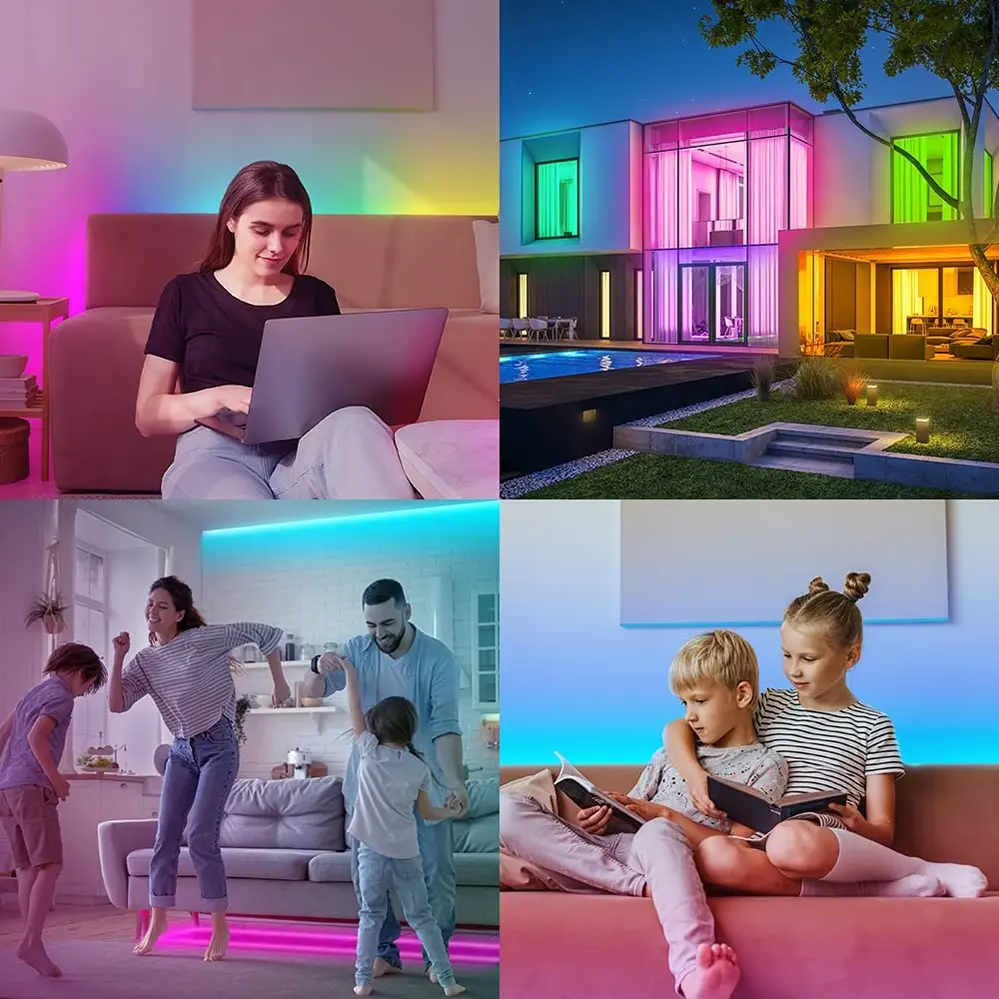When it comes to transforming your living space or professional environment with stunning RGB lighting, the choice between addressable and non-addressable LED strips can make all the difference. These two types of LED strips offer unique features and benefits that cater to different needs and preferences and often integrate with a microcontroller for enhanced control. Whether you’re looking to create a dynamic, customizable ambiance or simply want reliable, steady illumination, understanding the key differences between addressable and non-addressable LED strips is crucial.
Addressable RGB LED strips have revolutionized the lighting industry since their introduction in 2016. With their advanced programmable features, these strips allow you to control each individual LED, creating mesmerizing light shows, intricate designs, and seamless smart home integration. On the other hand, non-addressable LED strips offer a straightforward, reliable solution for those who prefer simplicity and ease of use. These strips provide consistent brightness without the need for complex control systems, making them an excellent choice for a variety of applications.
I’m Tom, and I’ve been immersed in the LED lighting industry since 2005. Over the years, I’ve gained extensive knowledge about LED lighting technology, particularly RGB LED strip lights. My experience has equipped me with the insights needed to help you make informed decisions about your lighting projects. In this blog post, I’ve meticulously compared addressable and non-addressable LED strips to provide you with a comprehensive guide that highlights their respective advantages and applications.
So, whether you’re a lighting enthusiast or a professional looking to enhance your space, this article is tailored just for you. Let’s dive right in and explore the fascinating world of addressable and non-addressable LED strips, and discover which option is the perfect fit for your needs!
Introduction to LED Strips

LED strips have revolutionized interior and exterior lighting solutions, providing versatility, energy efficiency, and endless possibilities for creative illumination.
Their rise in popularity showcases their transformative impact.
These narrow, flexible circuit boards adorned with light-emitting diodes (LEDs) have become a staple in both residential and commercial settings, redefining how spaces are lit, designed, and experienced.
The development of LED strip technology continues to evolve, enabling even more dynamic applications and innovative lighting designs that push the boundaries of what is possible regarding the frequency and complexity of lighting effects. This evolution, particularly evident in the comparison of addressable LED strips versus non-addressable ones, signifies a pivotal moment for enthusiasts and professionals alike.
What is an Addressable LED Strip?

An addressable LED strip is a lighting solution that allows for individual control of each LED on the strip.
Unlike traditional LED strips, where all LEDs operate in unison, addressable LED strips facilitate intricate lighting patterns through individual LED control.
These strips feature integrated circuit chips that enable each RGB LED or pixel to be programmed separately, creating dynamic and customizable lighting effects.
The versatility offered by addressable LED strips opens up a world of creative options, from mesmerizing animations to precise color transitions, making them ideal for complex installations.
In essence, addressable LED strips redefine the possibilities of lighting design, inviting both professionals and enthusiasts to explore innovative illumination techniques.
What is a Non-Addressable LED Strip?

A non-addressable LED strip is a type of lighting solution where all the LEDs on the strip function as a single unit.
In contrast to addressable RGB LED strips, non-addressable versions lack individual control over each LED.
This means, when power is supplied to the strip, all the LEDs emit light simultaneously with the same color and intensity.
Non-addressable LED strips are straightforward and particularly popular for simpler, more uniform lighting applications.
They require less complex control systems, making them both cost-effective and easier to implement for basic lighting needs.
Overall, while they might not offer the advanced capabilities of their addressable counterparts, non-addressable LED strips excel in scenarios that demand consistent and widespread illumination.
Key Differences between Addressable and Non-Addressable LED Strips
Addressable and non-addressable LED strips face a critical difference in control.
Addressable LED strips feature chips that allow for individual LED control. This key attribute enables users to craft intricate lighting patterns, animations, and color-changing sequences, making them exceptionally versatile. Consequently, these strips find themselves at the forefront of applications where dynamic lighting effects are paramount.
Non-addressable strips, however, offer a unified lighting response.
Powering such strips results in all LEDs lighting up concurrently – in both color and brightness – thus primarily serving cases where uniformity is favored over individuality.
Opting for either depends heavily on specific project needs. For advanced lighting, requiring intricate designs or responsive interactions, addressable RGB LED strips stand as the superior choice. Conversely, for more standardized lighting applications, non-addressable LED strips provide a reliable and cost-effective solution. Both forms have their place, enhancing environments through tailored illumination possibilities.
Installation Requirements
An addressable LED strip vs non-addressable LED strip entails distinct installation needs.
For addressable LED strips, the installation process can be more complex than their non-addressable counterparts. These strips require a dedicated controller, a specific power supply, and precise programming to achieve desired lighting effects. Consequently, they are suitable for installations where advanced lighting control and customization are essential.
Conversely, non-addressable LED strips require simpler installation procedures. With fewer components necessary, they can be conveniently installed using standard power supplies without the need for any controllers. This simplicity makes them particularly appealing for straightforward applications.
Overall, the installation expertise required to deploy addressable LED strips is higher compared to non-addressable LED strips. Nonetheless, the investment in a more intricate setup pays off through unmatched flexibility and dynamic lighting capabilities, which are well-suited for sophisticated design projects. By understanding the specific requirements, one can make an informed choice between these two options based on their installation prowess and desired outcomes.
Control and Customization
Control and customization are paramount advantages of addressable LED strips, enhancing users’ lighting environments with precision and creativity.
By offering the ability to individually control each LED, addressable strips allow for bespoke lighting designs, intricate animations, and color gradients. This high level of customization opens up a multitude of possibilities, transforming any space into a vibrant, dynamic setting.
In contrast, non-addressable strips offer a more uniform lighting solution. They are ideal for applications requiring consistent illumination with minimal adjustment.
Addressable LED Strip Controls
The controls for addressable LED strips are intricate, a hallmark of contemporary lighting solutions. Each LED can be programmed individually, allowing users to create complex lighting patterns.
With the use of controllers and software, users can achieve effects like “chasing lights”. This level of granularity ensures a bespoke lighting experience unrivaled in its versatility.
Technology empowers creative lighting solutions tailored to every unique need and vision.
Software platforms: advanced configurations synchronize the strips with music, transforming spaces into dynamic, pulsating environments. Moreover, app integration enables remote control, further enhancing user convenience and interaction.
Non-Addressable LED Strip Controls
Non-addressable LED strips, unlike their addressable counterparts, offer less customization but remain straightforward and easy to use.
For starters, non-addressable strips are managed through a basic setup involving a single controller. This controller drives the entire length of the strip, ensuring that all LEDs exhibit uniform brightness and color.
Consequently, this feature makes non-addressable strips an excellent choice for tasks where consistent illumination across the entire strip is paramount.
In conclusion, the simplicity and uniformity of non-addressable strips make them an ideal fit for functional and aesthetic applications. Those seeking reliable, even lighting without the need for detailed configurations will find non-addressable LED strips to be highly effective, furnishing spaces with consistent and appealing illumination.
Versatility and Use Cases
Addressable LED strips represent a versatile solution, enabling users to create complex lighting patterns, vibrant displays, and dynamic environments.

These strips excel in applications where tailored light effects are paramount.
Whether accenting architectural elements or setting the mood for an event, addressable strips provide unmatched adaptability.
Retail environments benefit from the flexibility to highlight different product features dynamically.
Moreover, their capacity for intricate programming is beneficial in professional stage lighting, where precision is crucial.
In contrast, non-addressable LED strips excel where uniform lighting is desirable. They remain a robust choice for straightforward, consistent illumination needs.

Cost Comparison
When considering LED strips, cost is a significant factor influencing the decision between addressable and non-addressable options.
As of 2023, addressable LED strips generally come at a higher price point due to their advanced functionality and programmability, often exceeding the cost of their non-addressable counterparts.
Non-addressable LED strips, while more affordable initially, may provide less flexibility in the long run. This might affect overall cost depending on the project’s evolving needs and goals.
However, it’s worth noting that the total cost of ownership includes not just the LED strips themselves but also installation, power supplies, and potentially control systems, especially for addressable LEDs.
Ultimately, determining the best value between addressable and non-addressable LED strips depends on the specific application and future scalability considerations.
Power Consumption
Power consumption is a critical consideration when comparing addressable and non-addressable LED strips.
In an addressable LED strip, each individual LED’s capability to be controlled separately often results in increased power consumption, especially at higher brightness levels or with more complex lighting patterns.
Conversely, non-addressable LEDs typically consume less power due to their simpler operational requirements.
Efficiency of Addressable LED Strips
Addressable LED strips offer exceptional efficiency through precise control over individual LEDs.
- Dynamic Color Control: These strips can display multiple colors simultaneously, enhancing visual appeal.
- Energy Optimization: Advanced controllers adjust brightness and colors to minimize energy use.
- Customizable Effects: Programmable effects maximize creativity without compromising energy efficiency.
- Minimal Wastage: Controlled lights mean only necessary LEDs are on, saving energy.
This fine control translates into impressive energy savings over time.
Such efficiencies make addressable LED strips an excellent choice for both cost-effectiveness and innovative design applications.
Efficiency of Non-Addressable LED Strips
Non-addressable LED strips shine in their simplicity and energy consumption, making them a cost-effective lighting option.
These strips usually draw less power, contributing to lower energy bills.
By illuminating all LEDs simultaneously with the same brightness and color, the energy consumption remains uniform and controlled, providing a predictable energy expenditure.
While lacking the fine-tuned control of addressable options, non-addressable LED strips boast consistent efficiency. This reliability makes them ideal for large-scale installations where maintaining a low overall power consumption is paramount. As they can’t be individually dimmed or color-tweaked, their straightforward design ensures steadfast performance, catering to applications that value simplicity over complexity.
Popular Brands and Models
In the realm of addressable LED strips, WS2812B stands out as a frontrunner known for its versatility and high performance.
Another notable name is the SK6812, which features advanced capabilities like RGBW color mixing, enhancing user experiences by offering more vibrant and customizable lighting options. These models have garnered a reputation for their robust performance, reliability, and ease of integration into various lighting projects, further solidifying their position as popular choices among enthusiasts and professionals alike.
Conversely, non-addressable LED strips often feature models like the 3528 and 5050. These units are celebrated for their simplicity and dependable operation, making them ideal for straightforward lighting needs and relatively easier installation.
Whether an individual is pursuing the sophistication of addressable strips or the simplicity of non-addressable ones, recognized brands like Philips Hue, LIFX, and Sylvania Vieanna offer products across both categories. Their varied selections meet the diverse requirements of lighting applications, presenting solutions that cater to every need, ensuring projects not only look impressive but also perform outstandingly well. Popular brands underscore the ongoing dedication to advancing LED technology, providing consumers with reliable, cutting-edge options to illuminate spaces creatively and efficiently.
In case you need to buy addressable or non-addressable LED strips in bulk, you can turn to Unitop who is one of the most professional manufacturers from China.
User Experience and Reviews
Users of addressable LED strips consistently report high levels of satisfaction due to their dynamic functionalities.
They appreciate the customizable lighting effects and precise control.
Reviews often highlight the enhanced aesthetic appeal these strips bring to both personal and commercial spaces. Users commend the seamless integration with smart home systems, praising the versatility and performance of these innovative lighting solutions.
Conversely, non-addressable LED strips receive accolades for their straightforward installation and reliable operation, proving valuable for those who prefer simplicity over complexity. Many users admire their durability and the consistent, bright illumination they provide, turning even the most basic setups into visually pleasing environments. Whether opting for the cutting-edge capabilities of addressable strips or the dependable nature of non-addressable ones, it is clear that LEDs have transformed lighting experiences for the better.
Conclusion
In summary, the decision between addressable and non-addressable LED strips pivots on one’s specific lighting goals and preferences. Addressable LED strips, celebrated for their advanced quick-adjust features, vibrant displays, and modern integration potential, elevate projects demanding dynamic and changeable lighting. Non-addressable LED strips, however, stand out for their straightforwardness, uniform light output, and ease handling, suitable for those aiming for stable and consistent illumination without the intricacies of intensive control. Both technologies offer unique pathways to revolutionize your lighting endeavors, ensuring spaces are illuminated effectively and impressively.
For those seeking expert guidance and high-quality LED solutions, contacting Unitop—a renowned Chinese manufacturer specializing in LED strip lights and LED neon strips—could be an exceptional choice. Unitop’s professionals possess the expertise and comprehensive products to cater to a wide range of lighting specifications, ensuring your project not only meets but exceeds expectations in both performance and aesthetic appeal. Reach out to Unitop today to embark on an innovative lighting journey that transforms your vision into reality with precision and excellence.





